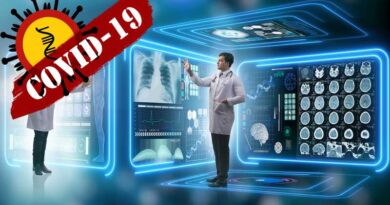Transforming Care Despite COVID Through Technological Capabilities
By Stacey-Ann Okoth, VP of Patient Care Services & Chief Nursing Officer, UPMC
While nursing care requires a human touch, the right technology can enhance it without taking away from the patient experience. Every interaction in the hospital is an opportunity to make a difference in a patient’s experience. As this is the most vulnerable time for many patients, it behooves everyone working in the health care environment to create a culture of caring.
Technology such as barcode medication administration (BCMA) is embedded in the safety culture at UPMC, a $21 billion world-renowned health care provider and insurer headquartered in Pittsburgh, with 40 total hospitals across Pennsylvania, Maryland, and New York. Nurses scan medications before delivering them to patients, which allows the nurse to either continue the administration process or provide a warning in real-time. The BCMA technology is also used in addition to the nurses’ responsibility to adhere to the five traditional rights of medication administration, including the right patient, right drug, right route, right dose, and the right time.
IV interoperability was the new best thing. Sadly, COVID played a considerable part in the challenges to the smooth transition of this technology.
In the past, nurses relied on their training and double-checking tactics by other nurses before delivering certain medications. This process was not always reliable or safe. BCMA allows no shortcuts in verifying patients since the patient’s armband must be scanned before proceeding with the administration. Nurses have reported feeling safer with this technology and do not want to go back to how it used to be. Patients, in turn, have appreciated the additional verification put in place for their safety.
The quest for superior technology is not a one-person job. Often, the informatics nurse is charged with the responsibility of seeking out such technology. However, many facilities have gotten wiser and learned the importance of collaboration across hospital departments. At UPMC, cross-department committees are formed for this very reason. Hospital employees, including representatives from the executive suite, nursing, pharmacy, Biomed, and several support departments, all get involved. They offer input into needed technology to support clinical and non-clinical areas.
Recently, a technology to integrate IV medication to interface with the documentation system kept everyone engaged. The implementation of IV interoperability was an exciting time for our nurses. This technology promised to decrease the amount of documentation needed for IV medications since it allowed bidirectional communication between the electronic medical record and the IV pump. After the nurse verifies medication order details and correctly identifies the patient, it infuses and communicates the volume infused to the patient’s electronic health record. Planning for this technology took months, and nurses were anxious for less documentation. Not surprisingly, nurses were lining up to be superusers; those who were selected for this role were responsible for learning the technology and training their colleagues. The superusers were additional resources to the informatics nurses and vendors.
IV interoperability was the new best thing. Sadly, COVID played a considerable part in the challenges to the smooth transition of this technology. Across the country, many hospitals were ravaged with patients that relied on critical care units to survive the coronavirus, thus placing a strain on resources, including IV pumps. Necessary medications required rapid infusions or multiple medications infusing at once.
According to Rust (2017), common reasons for noncompliance are that the user is in a hurry, does not thoroughly read the instructions on operating the device, doesn’t understand their skill level, and makes inaccurate assumptions. Although the rollout was planned meticulously, the steps required to ensure usage compliance proved to be more of a hindrance than a help to clinical staff. The new technology was frustrating for nurses who already had an intolerance for technology, and many didn’t have time to troubleshoot. Of course, these issues weren’t recognized during the implementation stage of the rollout; with so many people around to assist and answer questions in real-time, nurses felt comfortable at the time. Consequently, superusers and nurse informaticists were deployed to clinical areas to address concerns.
Pharmacy is a great partner in making adjustments based on the clinical employees’ feedback. The clinical data realized from this technology provide improved operational efficiency. Providers appreciate timely and accurate documentation of the infusion to make clinical decisions about the patient resulting in enhanced care and recovery.
The implementation of infusion pump interoperability also has implications on the business aspect of health care. Studies have shown that this technology improves hospital revenue (Suess et al., 2019). The increased revenue is mostly due to the automatic documentation of start and stop time for intravenous medications, resulting in increased claims. Prior to this technology, start and stop times for infusions were not consistently documented. Suess et al. (2019) reported over a $660,000 increase in inpatient hospital areas’ revenue post-implementation of IV pump interoperability.
The challenges to implementing technology in the health care workspace can be overwhelming. However, the benefits far outweigh the drawbacks. The lesson here is that nurses must be engaged in discovering, initiating, and implementing technology while understanding its impact on patient outcomes. Not leveraging technology may create a disadvantage for patients where they miss out on the many rewards, including enhanced quality and safety. Patients benefit from IV interoperability as well. Knowing that this technology offers another safety and quality level through accurate documentation is a win for patients.
Patients don’t choose to be in the hospital, and while they are admitted, they deserve to know that every tool is being used to ensure they receive the highest level of care possible. It suffices to say that all patients deserve the very best and incorporating the right technology with health care providers’ individualized care is paramount to this.



